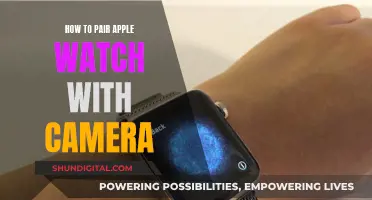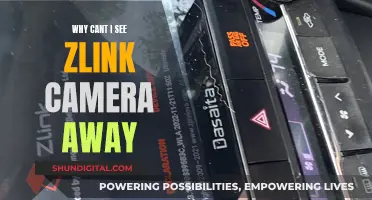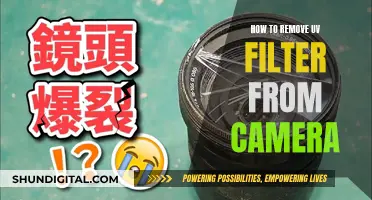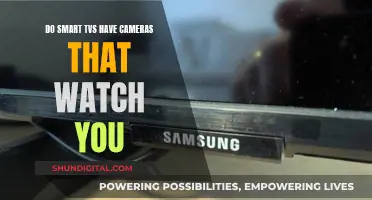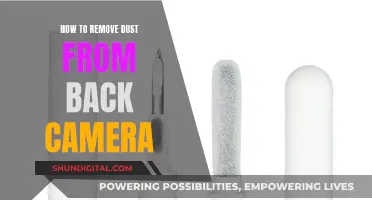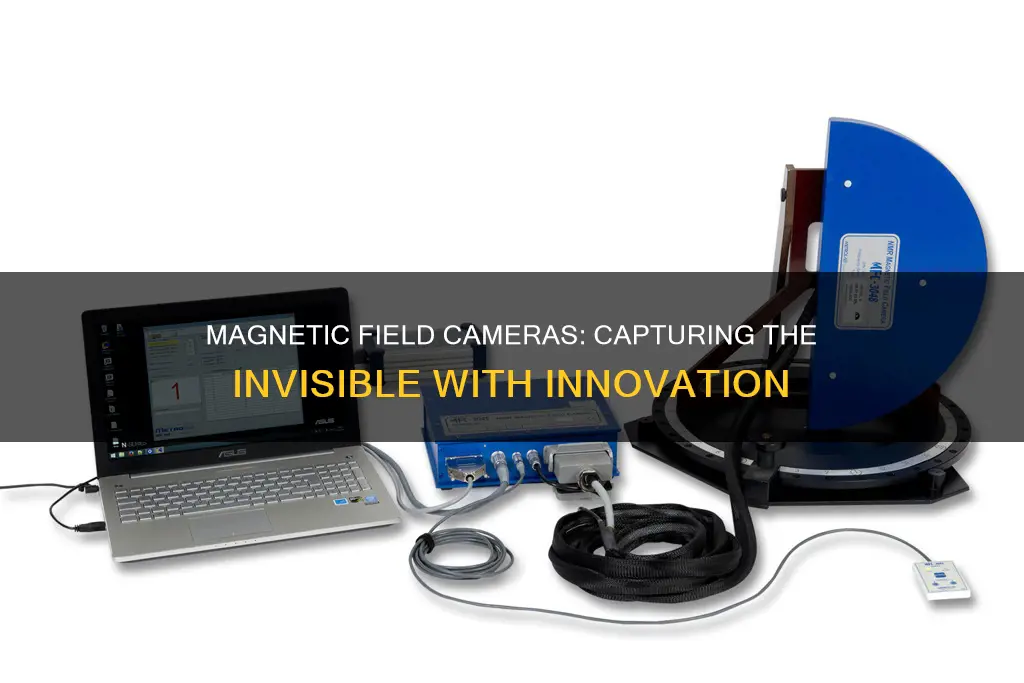
Magnetic field cameras are a reality, and they can be used to see magnetic fields in real-time. These cameras use a variety of technologies, such as Hall-effect sensors, magnetometers, and magnetic field imaging systems, to capture and display magnetic field distributions. The cameras have applications in various industries, including automotive, consumer electronics, and renewable energy. They can also be used for quality assurance during the manufacturing of magnets. While these cameras don't use lenses or boxes, they are a fantastic way to visualize magnetic fields, with some even being able to distinguish between the North and South poles of a magnet.
| Characteristics | Values |
|---|---|
| Purpose | Visualise magnetic fields |
| Mechanism | 2D array of magnetic sensors |
| Resolution | 12x12 grid of Hall effect sensors |
| Speed | 1000 images per second |
| Field Detection Range | From several μT up to a few T |
| Field Detection Rate | 25, 100, and 250 Hz |
| Field Vector Resolution | 4 μT |
| Field Vector Rate | Up to 1 kHz |
| Field Vector Measurement | All three axes |
| Field Line Measurement | 32 positions, 2.5 mm apart |
| Field Line Distance | 8 cm |
| Sensor Size | 0.1 x 0.1 mm2 |
| Sensor Type | 3D Hall-effect sensor |
| Interface | USB |
What You'll Learn

Magnetic field cameras can be used to detect hidden ferromagnetic objects
Magnetovision is a technique that measures the distribution of magnetic field induction in a specific plane or space and presents it as a 2D or 3D image. The colour in the image corresponds to the magnetic flux density or the value of the magnetic field strength at a given point.
A measurement system was developed to study the Earth's magnetic field distortions caused by various ferromagnetic objects. This system can be used to passively detect and determine the location of dangerous ferromagnetic objects. It is especially useful for detecting landmines and IEDs (improvised explosive devices) as it does not use an active metal detector induction field that can be sensed by specially constructed detonators.
Another example of a magnetic field camera is the B-Camera, which uses an array of AMR (anisotropic magneto-resistance) three-axis magnetometers to capture the spatio-temporal distribution of magnetic flux density in real time. The B-Camera was used to detect a nickel coin, a 9V dry-cell battery, and a loaded power-line cable.
Additionally, there are magnetic field cameras designed to measure the magnetic fields of permanent magnets, such as the MiniCube 3D, which can measure the entire magnetic field with accuracy up to 0.1 mT in less than 1 second.
Understanding Camera Quality: TV Lines Explained
You may want to see also

They can be used to detect cracks in ferrous parts
Magnetic field cameras can be used to detect cracks in ferrous parts. This is done by placing a magnet on one side of the part and using the camera to look for anomalies in the resulting magnetic field. This technique is known as magnetic particle inspection (MPI) or magnetic particle testing (MPT).
MPI is a non-destructive testing (NDT) process that is used to detect surface and shallow subsurface discontinuities in ferromagnetic materials. The component under test is magnetized, which causes a magnetic flux to be introduced within the component. If there are any surface-breaking defects, the flux will be distorted, resulting in leakage around the defect. This leakage can be visualized using magnetic particles, which are attracted to the areas of flux leakage.
MPI can be performed using a variety of magnetization techniques, including current-flow prods, threaded bars, and alternating current (AC) yokes. The direction of the magnetic field should be perpendicular to the line of the flaw for optimal detection. Fluorescent magnetic particles or surface-deployed paints can be used to aid in the visualization of the leakage field.
MPI is a sensitive and cost-effective method for detecting surface-breaking cracks in ferromagnetic materials. However, it is important to note that MPI is less effective for detecting subsurface discontinuities and cracks that run parallel to the magnetic field. Additionally, MPI may leave residual magnetic fields that can interfere with welding repairs.
Stream Live Feed from Your Mercury Camera
You may want to see also

They can be used to qualify permanent magnets
Magnetic field cameras can be used to qualify permanent magnets by measuring their magnetic fields. This can be done in real-time, providing a high-resolution video of the magnetic flux density. This can be useful for detecting hidden ferromagnetic objects and for mapping the distribution of a magnetic field near a power-line cable.
One way to do this is to use an array of AMR (anisotropic magneto-resistance) or GMR (giant magneto-resistance) three-axis magnetometers. These sensors measure the change in resistance of a material due to the impact of a magnetic field. The data from these sensors can then be interpolated to create a smooth image of the magnetic field.
Another method is to use iron powder, which will align with the magnetic field and provide a visual representation of the field lines.
Viewing Wyze Cameras on PC: A Simple Guide
You may want to see also

They can be used to detect small currents in wires
Magnetic field cameras are indeed a real thing. These cameras are designed to capture and display the magnetic field distribution of a region. They can be used to detect small currents in wires.
The magnetic field produced by a current in a straight wire can be calculated using the equation:
> The strength of a magnetic field, B, some distance, r, away from a straight wire carrying a current, I, can be found using the equation B = (μ0 x I) / (2π x r), where μ0 is a constant known as "the permeability of free space" and has the value 4π x 10^-7 T·m/A.
The strength of the magnetic field, B, decreases as the distance, r, away from the wire increases. This relationship is described by the equation:
> B ∝ 1/r
This means that the magnetic field strength approaches zero as r becomes very large.
To detect small currents in wires using a magnetic field camera, the camera's array of magnetometers would need to be positioned close to the wire. The camera would then be able to capture and display the magnetic field distribution, allowing the user to observe the presence and direction of the magnetic field produced by the current in the wire.
Additionally, the high sampling rate of the sensors in the camera could also allow for the measurement and mapping of the distribution of a magnetic field near a loaded power-line cable. This was demonstrated in an experiment where a magnetic field camera was used to image a loaded 50 Hz power-line cable. The camera was placed 3 cm above the cable and was able to capture the magnetic field distribution, which was proportional to the current in the cable.
Overall, magnetic field cameras have the capability to detect small currents in wires by visualizing the magnetic field distribution in the surrounding area.
Smart TV Features: Microphone and Camera Privacy Concerns
You may want to see also

They can be used to characterise the magnetisation of magnets
Magnetic field cameras are indeed a reality. These cameras are designed to capture and display the magnetic field distribution of a region. They can be used to characterise the magnetisation of magnets by providing a visual representation of the magnetic field's strength and direction.
The working principle of a magnetic field camera is based on an array of magnetometers that simultaneously measure the magnetic field values on a regular grid in front of the camera. The data collected by the magnetometer array is then sent to a processing and display unit (PDU). The PDU uses advanced algorithms to interpolate the magnetic field data and generate a high-resolution visual representation of the magnetic field.
One example of a magnetic field camera is the B-Camera, which employs a set of AMR (anisotropic magneto-resistance) three-axis magnetometers arranged in a two-dimensional sensor array. The B-Camera is capable of capturing and displaying the magnetic field distribution in real time, making it a valuable tool for various applications.
Another example is the MiniCube 3D, a magnetic field camera offered by Magcam. This camera uses an on-chip 2D array of Hall sensors to measure the entire magnetic field with high accuracy. It can provide measurements in less than 1 second, making it suitable for various industrial applications.
Magnetic field cameras can be used to characterise the magnetisation of magnets by visualising the magnetic field lines and their density. The density of the field lines represents the strength of the magnetic field, with closer lines indicating a stronger field. By observing the visual output of a magnetic field camera, one can gain insights into the magnetisation characteristics of the magnet.
Additionally, magnetic field cameras can also detect hidden ferromagnetic objects and map the distribution of magnetic fields near power lines or electrical appliances. This makes them useful in various industries, including renewable energy, automotive, and consumer electronics.
LG TV Camera: What You Need to Know
You may want to see also
Frequently asked questions
A magnetic field camera is a device that uses magnetic sensors to detect and visualise magnetic fields. The sensors are arranged in a grid and connected to a microcontroller, which processes the data and sends it to a display unit.
Magnetic field cameras use magnetic sensors, such as Hall-effect sensors or magnetometers, to detect and measure the strength and direction of magnetic fields. The sensors are arranged in a grid to capture data from multiple points, which is then processed to create a visual representation of the magnetic field.
Magnetic field cameras have a range of applications, including quality assurance in manufacturing, detection of hidden ferromagnetic objects, and visualisation of magnetic fields in motors and generators. They can also be used for educational purposes, such as demonstrating the principles of magnetism.
Yes, there are different types of magnetic field cameras, including 2D and 3D cameras. 2D cameras use a 2D array of sensors to capture data from a flat surface, while 3D cameras can capture data from multiple directions to create a more comprehensive visualisation of the magnetic field.
There are a few companies that sell magnetic field cameras, such as Magcam, Metrolab, and GMW Associates. These companies offer different models with varying specifications, so you can choose the one that best suits your needs.


